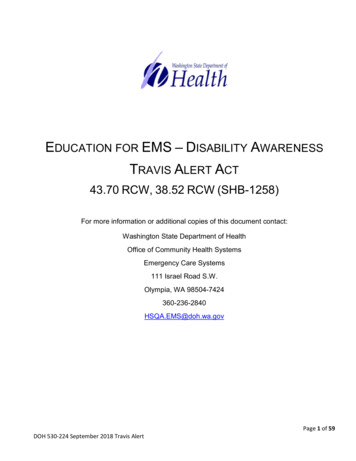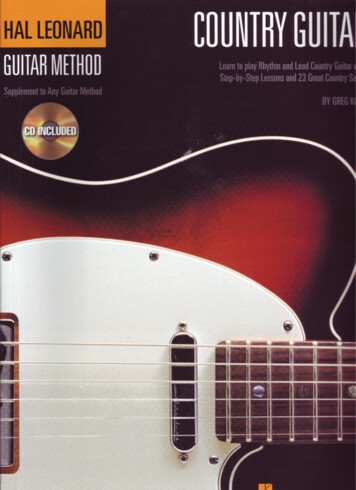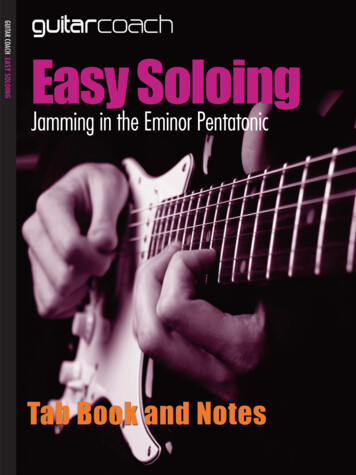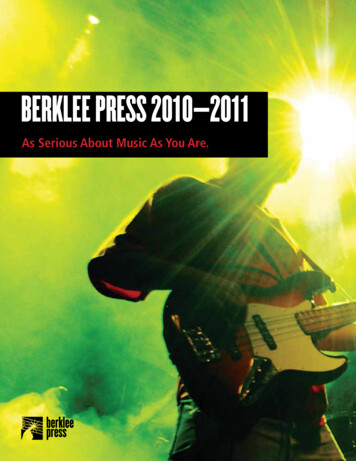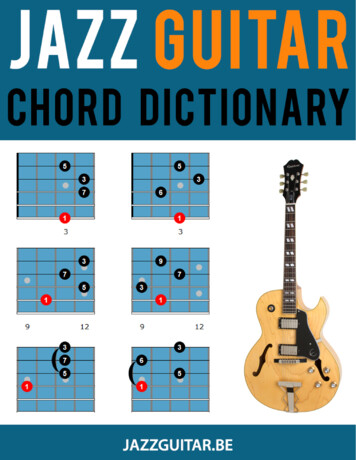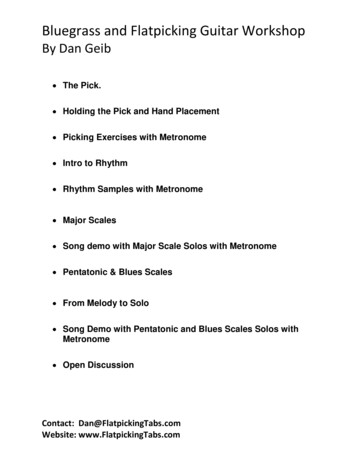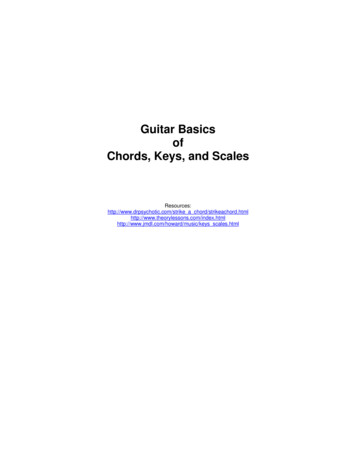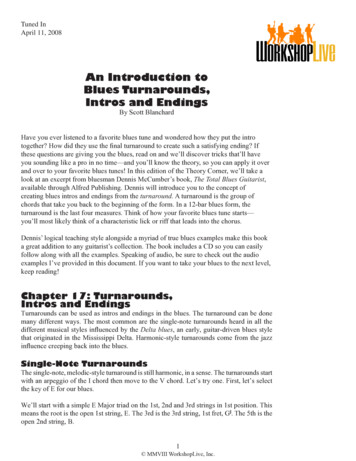
Transcription
How To Travis Pick:4 Simple PatternsFor The FingerstyleGuitaristbyDan Thorpe
Copyright 2016All rights reserved. No part of this book may be editedwithout the prior written permission of the publisher. Youare free to distribute it in its current, exact form.DisclaimerAll the material contained in this book is provided nsibility can be taken for any results or outcomesresulting from the use of this material.While every attempt has been made to provide informationthat is both accurate and effective, the author does notassume any responsibility for the accuracy or use/misuse ofthis information.
Free eBooksPlease note, this book is currently available for free, but Amazondoes not allow eBooks to be published for free unless in unusualcircumstances, so if you would like this book for free in bothKindle and PDF formats, head to Guitardomination.net/free.You can then join the free mailing list and get the best tips, tricks,free eBooks and other goodies sent to your inbox.ReviewsIf you enjoy this book, please head over to Amazon and leave it areview. I ll be forever grateful and will even buy you a drink if weever meet in person!The Elite Guitarist Inner CircleIf you enjoy this free eBook, you may like to join a monthlyprogramme where you get new video song lessons, an in-depth,in-focus technique builder, personalised coaching from me, and awhole lot more all for a very low price. If so, click HERE for more
details.5Go to http://guitardomination.net for more free articles and guitarresources
Table of ContentsIntroduction . 7Essential Tips To Get You Started .10Pattern #1 .22Pattern #2 .27Pattern #3 .33Pattern #4 .39How To Adapt These Patterns For Everyday Use .45Conclusion .506Go to http://guitardomination.net for more free articles and guitarresources
IntroductionTravis picking is a wonderful and distinctive style of fingerpickingthat takes its name from the great Merle Travis who popularisedthis style of playing in the 1940s and 50s.He didn’t invent the style but he made it very popular amongstroots, traditional, folk, country and even some rock musicians.There are lots and lots of songs that use this style of picking andyou’ll see a list of some of those later on in the book.Get good at Travis picking and you’ll be well on your way tobecoming good at fingerpicking.If you have ever read my blog and watched any of my lessons atGuitar Domination, you will know how much I love to fingerpick. Iwas once not really very good at it.I didn’t really know what my fingers should be doing and I didn’t7Go to http://guitardomination.net for more free articles and guitarresources
have any awareness of specific Travis style patterns.This really hampered me when I tried learning how to play somefingerpicking songs.I remember attempting Ralph McTell’s classic number — Streets ofLondon .I remember not getting very far with it because my picking handwas all over the place.That changed when I learnt to Travis Pick.Travis picking quickly became the backbone of my fingerstyle guitarplaying and I quickly realised how many songs actually used thisstyle.There is, of course, a lot more to fingerpicking than just Travispicking, but it is a great place to start.Before we get stuck into the four Travis picking patterns in thebook, let’s first find out exactly what Travis picking is.The most distinctive thing about Travis picking is the alternating8Go to http://guitardomination.net for more free articles and guitarresources
bass combined with picking on the higher strings.If that sounds confusing at all, fear not. It is actually very simpleand I’ll show you how to Travis pick in the simplest way from thevery first example.There are four examples in this book. The first is simple and eachone gets slightly harder, but not too hard!Each example has an A section and a B section.The A section features no ‘pinch’ and the B section features a’pinch’ on the first beat.When we get to the examples, you’ll discover all four examples indetail, along with what a ’pinch’ is, how to play it, and you’ll hearthe patterns in action via the audio ’playalongs’.9Go to http://guitardomination.net for more free articles and guitarresources
Essential TipsTo Get YouStartedIf you have never Travis picked, or indeed fingerpicked before, thenthe following will help you get started.10Go to http://guitardomination.net for more free articles and guitarresources
Viewing The TabViewing images clearly on a Kindle can be notoriously difficult.Therefore, if you are reading this book on a Kindle, you may needto double click on the image or pinch it to expand it so you can seethe tab clearly. Also, depending on your Kindle you may need toturn the Kindle 90 degrees.If you find this still doesn t work and you can t see the tab clearly,you can download just the tab here as a PDF and print this out andkeep it next to you while going through the book.If you are reading the PDF version of the book, you can zoom in tosee the tab clearer.11Go to http://guitardomination.net for more free articles and guitarresources
This is highly encouraged for you to get the best out of thesepatterns.12Go to http://guitardomination.net for more free articles and guitarresources
The Audio PlayalongsAlso, don’t forget the audio is designed for you to play alongwith, so listen to the fast version first and then try and playalongwith the slow version.You can either stream the audio or download all sixteen tracks inone handy zip file so you can store them and listen to them on yourcomputer using your favourite media player.The descriptions have already been done for you too. So just ’unzip’the folder and then press play.Click HERE to download or stream the audio for this eBookGo through each Travis picking pattern as many times as it takes toget comfortable playing them and as soon as you feelreasonably comfortable try playing along with therecordings.This will ensure your timing, accuracy and tone will be up to thehighest standard.13Go to http://guitardomination.net for more free articles and guitarresources
The PatternsEach of the four patterns in this book comes with both a slowversion and a fast version of the audio so you can hear thepatterns in action and play-along with them.The patterns are one bar in length and are played for four times oneach chord in the audio playalongs.That means you will get:- 4 bars of GAND- 4 bars of C on each recording.When learning the patterns, it’s very important to follow the exactrhythm. Three out of the four patterns have six plucks, but theseplucks are in a different order and, most importantly, use differentrhythms.14Go to http://guitardomination.net for more free articles and guitarresources
It’s these rhythms that give each of the patterns its own uniqueflavour.In the real world you may find that you only play one bar (ormaybe two bars) on each chord before changing, but wheneveryou are learning something new with your picking hand itis useful to practice it on one chord for a longer period oftime (i.e. four bars).Doing it this way will give you less things to think about.Look at it this way, if you were to change chord every bar AND belearning these patterns, then that is a lot to think about.Each of the patterns is taught with bass string plucks played withthe thumb and G string plucks played with the index finger.This is done for simplicities sake and to keep things consistent tomake it easier for you to learn.Once you have learnt the patterns, feel free to swap the G stringplucks for B string or high E string plucks. Doing so will add moreflavour to the patterns.15Go to http://guitardomination.net for more free articles and guitarresources
TerminologyTo avoid confusion throughout this book I will refer to the fingersand strings of the guitar in a certain way.StringsThe six strings of the guitar will be described as their open stringnotes and NOT their string number.6 Low E5 A4 D3 G2 B1 High E16Go to http://guitardomination.net for more free articles and guitarresources
You may call the low E the “sixth string” but I will describe it as the“low E” string.This makes it easier for most students to understand.FingersThroughout the book, I will describe the fingers of both the frettingand picking hands by their names and not their numbers.ThumbIndexMiddleRingPinkie17Go to http://guitardomination.net for more free articles and guitarresources
Which fingers pick which string?Generally, when fingerpicking the:Thumb plays the bass strings (low E, A and D)Index finger plays G stringMiddle finger plays B stringRing finger plays high E stringFollow this guideline throughout and you’ll find that beingconsistent with the above will yield better results.Let the fun of Travis picking begin 18Go to http://guitardomination.net for more free articles and guitarresources
Chords Used In This BookFor simplicities sake, instead of showing you these patterns on lotsof chords, I will simply show you them on two chords.These two chords are G Major and C Major.I have chosen these two chords as they are two of the mostpopular on the guitar and almost everybody knows them!19Go to http://guitardomination.net for more free articles and guitarresources
An Easy Alternative to C MajorFor many beginners, changing from G Major to C Major can bequite difficult.Therefore, for these examples in this book you can play a C Major 7instead of C Major while learning the patterns.The examples I have given you don t actually feature picking onthe B string which is the string that makes these two chordsdifferent from each other.20Go to http://guitardomination.net for more free articles and guitarresources
If you choose to use the C Major 7, then changing from G Majoris much easier.You can simply, move your index and middle fingers from the low Estring and A string for the G Major chord to the A string and Dstring for the C Major 7 chord.(Also, remember you need your ring finger for the G chord).21Go to http://guitardomination.net for more free articles and guitarresources
Pattern #1Pattern #1 is a very simple pattern that is designed to get youstarted Travis Picking properly.Just because it is simple, it doesn’t mean it won’t sound good!This pattern features just four plucks per bar.22Go to http://guitardomination.net for more free articles and guitarresources
Pattern #1aThe G Major chordThe above features four plucks. To get started first play the shapefor the G Major chord as shown earlier on in the book.To play one bar of the pattern, follow these steps Step 1 - The first pluck is a root note played with the thumb andthis pluck is played on the 3rd fret of the low E string.Step 2 - Follow that up with a pluck on the open G string with the23Go to http://guitardomination.net for more free articles and guitarresources
index finger.Step 3 – Now comes the alternate bass note which is played onthe 2nd fret of the A string with the thumb.Step 4 – Follow that up once again with a pluck on the open Gstring with your index finger.The C Major chordFollow the same steps as above but because the root note of the CMajor chord is on the A string, we simply shift the thumb plucks tothe string above.In other words, the thumb plucks for these Travis picking patternsoccur on strings:- Low E and A for the G Major chord- A and D for the C Major chord24Go to http://guitardomination.net for more free articles and guitarresources
Pattern 1bThe alternate version of this pattern which we will call 1b is exactlythe same as version 1a, but this time we are adding a pinch on thefirst pluck of each bar.To play the pinch, simply pluck the high E string with your ringfinger at the same time as you pluck the low E string (for the Gchord) or A string (for the C chord) with your thumb.25Go to http://guitardomination.net for more free articles and guitarresources
Take your time playing this pattern and have fun with it.It is a basic Travis picking pattern but it is still very useful tolearn.Once you get comfortable with it, try increasing the speed andplaying it with a variety of chords!When you have learnt the pattern, feel free to change which of thetreble strings you pluck.For example, whenever there is a pluck on the G string, you caninstead pluck the B string or the high E string.Remember, you can click here to listen to or download the audio forthis eBook.26Go to http://guitardomination.net for more free articles and guitarresources
Pattern #2Pattern #2 is a more intricate pattern that focuses more on thebass strings so you can really feel and hear ‘that Travis pickingsound.’This pattern features six plucks per bar.27Go to http://guitardomination.net for more free articles and guitarresources
Pattern #2aThe G Major chordThe above features six plucks. To get started first play the shapefor the G Major chord as shown earlier on in the book.To play one bar of the pattern, follow these steps Step 1 - The first pluck is a root note played with the thumb andthis pluck is played on the low E string.Step 2 - Now comes the alternate bass note which is played on28Go to http://guitardomination.net for more free articles and guitarresources
the 2nd fret of the A string with the thumb.Step 3 – Now we play another root bass note which is playedwith the thumb and this pluck is played on the low E string.Step 4 – Follow that up with a pluck on the open G string with theindex finger.Step 5 – Now comes another alternate bass note which is playedon the 2nd fret of the A string with the thumbStep 6 – Follow that up with another pluck on the open G stringwith the index finger.The C Major chordFollow the same steps as above but because the root note of the CMajor chord is on the A string, we simply shift the thumb plucks tothe string above.29Go to http://guitardomination.net for more free articles and guitarresources
In other words, the thumb plucks for these Travis picking patternsoccur on strings:- Low E and A for the G Major chord- A and D for the C Major chord30Go to http://guitardomination.net for more free articles and guitarresources
Pattern 2bThe alternate version of this pattern which we will call 2b is exactlythe same as version 2a, but this time we are adding a pinch on thefirst pluck of each bar.To play the pinch, simply pluck the high E string with your ringfinger at the same time as you pluck the low E string (for the Gchord) or A string (for the C chord) with your thumb.31Go to http://guitardomination.net for more free articles and guitarresources
This is a really cool pattern that focuses on the bass quite a bit.Once you have learnt all four patterns in this book you couldcombine a couple of patterns for your own songs orarrangements.For example, this pattern may sound good for a verse, as it focuseson the lower notes. You may then want to play another pattern thatfocuses on the treble strings for your chorus.The choice is yours.First, get comfortable playing this pattern at both a fast and firstly aslower speed.Remember, you can click here to listen to or download the audio forthis eBook.32Go to http://guitardomination.net for more free articles and guitarresources
Pattern #3Pattern #3 is a little more interesting from a rhythmic point ofview and is probably a little more usable than the previous twopatterns.This pattern features six plucks per bar.33Go to http://guitardomination.net for more free articles and guitarresources
Pattern #3aThe G Major chordThe above also features six plucks but it uses a different rhythmand picking order to pattern #2.To get started first play the shape for the G Major chord as shownearlier on in the book.To play one bar of the pattern, follow these steps Step 1 – The first pluck is a root note played with the thumb and34Go to http://guitardomination.net for more free articles and guitarresources
this pluck is played on the low E string.Step 2 – Now comes the alternate bass note which is played onthe 2nd fret of the A string with the thumb.Step 3 – Follow that up with a pluck on the open G string with theindex finger.Step 4 – Now play a root note with the thumb and this pluck isagain played on the low E string.Step 5 – Follow that up with another pluck on the open G stringwith the index finger.Step 6 – Finish the pattern with another alternate bass notewhich is played on the 2nd fret of the A string with the thumb.The C Major chordFollow the same steps as above but because the root note of the C35Go to http://guitardomination.net for more free articles and guitarresources
Major chord is on the A string, we simply shift the thumb plucks tothe string above.In other words, the thumb plucks for these Travis picking patternsoccur on strings:- Low E and A for the G Major chord- A and D for the C Major chord36Go to http://guitardomination.net for more free articles and guitarresources
Pattern 3bThe alternate version of this pattern which we will call 3b is exactlythe same as version 3a, but this time we are adding a pinch on thefirst pluck of each bar.To play the pinch, simply pluck the high E string with your ringfinger at the same time as you pluck the low E string (for the Gchord) or A string (for the C chord) with your thumb.37Go to http://guitardomination.net for more free articles and guitarresources
Although this pattern has six plucks just like pattern #2 and #3, ithas a different rhythm.It also finishes on a bass note which makes it a little differentand more interesting.You can use this pattern for a whole song or use it to break up asong if it primarily uses another Travis picking pattern.As always, get comfortable playing this pattern at the slower speedon the playalong recording.Once you are able to play it at the slower speed, try it at the fasterspeed and then try any tempo you like!Remember, you can click here to listen to or download the audio forthis eBook.38Go to http://guitardomination.net for more free articles and guitarresources
Pattern #4Pattern #4 is a more syncopated Travis picking pattern thatfollows the rhythm which I call The Ultimate Strum pattern.If you know that strum pattern, see if you can recognise its rhythmin this pattern.This pattern features six plucks per bar.39Go to http://guitardomination.net for more free articles and guitarresources
Pattern #4aThe G Major chordThe above features six plucks but with a different rhythm andpicking order to patterns #2 and #3.To get started first play the shape for the G Major chord as shownearlier on in the book.To play one bar of the pattern, follow these steps Step 1 – The first pluck is a root note played with the thumb and40Go to http://guitardomination.net for more free articles and guitarresources
this pluck is played on the low E string.Step 2 – Follow that up with a pluck on the open G string with theindex finger.Step 3 – Now comes the alternate bass note which is played onthe 2nd fret of the A string with the thumb.Step 4 – Follow that up with a pluck on the open G string with theindex finger.Step 5 – Follow that up with a root note played with the thumband this pluck is played on the low E string.Step 6 – Finish the pattern with an open G string with the indexfinger.The C Major chordFollow the same steps as above but because the root note of the C41Go to http://guitardomination.net for more free articles and guitarresources
Major chord is on the A string, we simply shift the thumb plucks tothe string above.In other words, the thumb plucks for these Travis picking patternsoccur on strings:- Low E and A for the G Major chord- A and D for the C Major chord42Go to http://guitardomination.net for more free articles and guitarresources
Pattern 4bThe alternate version of this pattern which we will call 4b is exactlythe same as version 4a, but this time we are adding a pinch on thefirst pluck of each bar.To play the pinch, simply pluck the high E string with your ringfinger at the same time as you pluck the low E string (for the Gchord) or A string (for the C chord) with your thumb.43Go to http://guitardomination.net for more free articles and guitarresources
Out of all four of the fingerpicking patterns in this book, this one isthe most syncopated.Syncopation is when we play on the off-beat rather than onthe beat .Although the pattern isn t majorly syncopated, the groove itcreates is lovely and very applicable.If you know lots of songs that use the Ultimate Strum pattern, and you want to create your own fingerpickingarrangement of the song, instead of strumming, use this pattern. Itwill sound great.Remember, you can click here to listen to or download the audio forthis eBook.44Go to http://guitardomination.net for more free articles and guitarresources
How To AdaptThese PatternsFor EverydayUseBelow are multiple ways you can adapt these patterns for your ownsongs, arrangements or general day to day use.Combine different patternsTry combining the patterns. For example, play one bar of pattern 2band then follow that up with one bar of pattern 3a.45Go to http://guitardomination.net for more free articles and guitarresources
Combining patterns like this can help you create some really uniquesuper-patterns!Change which treble strings you pluckTry swapping some of the treble strings, so instead of plucking theopen G string with your index finger you can play the B string withyour middle finger or you can play the high E string with your ringfinger.You can also change the pinch note that is shown in the b versions of the examples.So, instead of plucking the low E string and the high E string foryour pinch, you could pluck the low E string and the B string, or thelow E string and the G string.There are lots of different variations you can create with thesepatterns and don t forget you can use lots of different beautiful andlush chords too.46Go to http://guitardomination.net for more free articles and guitarresources
Songs that use Travis PickingYou can create your own Travis picking arrangements of prettymuch most songs you know – especially if it s a strumming song.Simply take the chords and instead of strumming them, apply oneof the above Travis picking patterns (or any others you know) andtake it away.Music is about fun, joy and freedom. Enjoy applying Travis pickingto your favourite songs. It s a great way to practice the technique.Below is a small list of classic Travis picking songs.47Go to http://guitardomination.net for more free articles and guitarresources
Kansas - Dust in The WindBob Dylan – Don t Think Twice It s AlrightFleetwood Mac – Never Going Back AgainSimon & Garfunkel - The BoxerMark Knopfler – Postcards From ParaguayPearl Jam – Just BreatheMerle Travis – Nine Pound HammerEddie Vedder – GuaranteedChet Atkins – Jam ManRichard Thompson - 1952 Vincent Black LightningThe above is just a short list. There are loads more!Keep your ears peeled and you ll hear lots of songs that you haveheard before in a new light as you will now think to yourself:48Go to http://guitardomination.net for more free articles and guitarresources
“Oh, that sounds like Travis picking, I think I ll learn that one”.That s what I did.49Go to http://guitardomination.net for more free articles and guitarresources
ConclusionIf you haven t already, make sure you play along with therecordings for all the examples and the four patterns in this book.Go here to download or stream the audio and click here to get aprintable tab sheet.I hope you enjoyed this short but highly effective eBook.Learn and master each of the four Travis picking patterns andyour fingerpicking guitar skills will be better for it.Be the best guitarist you can be.Thank you and I wish you all the best!Dan ThorpeGuitar Domination50Go to http://guitardomination.net for more free articles and guitarresources
Email me at hq@guitardomination.net for any questions or just tolet me know how you get on.I love to hear how these techniques help you to achieve your guitarplaying dreams.51Go to http://guitardomination.net for more free articles and guitarresources
Join the free mailing list to get moregreat content for freeI m always proud of the free content I deliver. I try to ensure myfree stuff is better than other people s paid stuff and over the yearsI have had some wonderful feedback on the free materials I put outthere.If you want to join over 10,000 other guitarists who, just like youlove to fingerpick their guitars, then you can do so on the linkbelow.Doing so will get you access to another great eBook, as well as lotsof good stuff coming your way soon.Join over 10,000 others on the Guitar Domination mailinglist.52Go to http://guitardomination.net for more free articles and guitarresources
A Small favour and a special offerIf you enjoyed this book, could I ask you a small favour?Could you please head to Amazon and leave it a positive review?5 star reviews are amazing for independent authors such asmyself.They help encourage others to read my books and they help keepGuitar Domination a success which allows me to create moreawesome content for you all.If you want to leave a review, then you can do so on the relevantlink for your country below .Amazon USAmazon UKAmazon AustraliaAmazon Canada53Go to http://guitardomination.net for more free articles and guitarresources
Amazon GermanyThe Guitar Domination Super BookBundleIf you enjoyed this book then you may like to check out my otherbooks for sale.They are for sale individually but if you get them directly on the linkbelow, you will get 7 of my best selling multiple 5 star rated eBooks54Go to http://guitardomination.net for more free articles and guitarresources
all available in both PDF and Kindle formats for a cheaper price andin one handy package.Check it out on the link below .The Guitar Domination Super Book Bundle55Go to http://guitardomination.net for more free articles and guitarresources
Other resources available from theauthor .Dan Thorpe has two tuition web sites:Guitar Domination – A free resource for all guitarists to learn andenjoy from.Elite Guitarist – A selection of courses aimed at making you theabsolute best guitarist you can be.These range from strumming, chord changes, essential beginnerguitar skills and more.I would like to thank the creators of the following image forallowing me to use them in this eBook under the creative commonslicence.Bryan Ledgard for his photo titled Jed Grimes 56Go to http://guitardomination.net for more free articles and guitarresources
I would also like to thank every single student I have ever taught.Either the 100 s I have taught in person and via group classes orthe 10,000 s from around the world.You make teaching the guitar more inspiring every day!57Go to http://guitardomination.net for more free articles and guitarresources
you can download just the tab here as a PDF and print this out and keep it next to you while going through the book.
